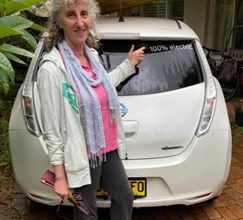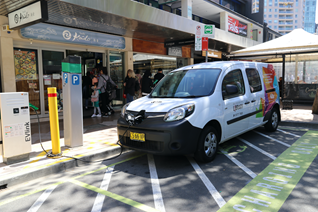Electric Vehicles
Willoughby City Council promotes sustainable transport and is working towards creating a liveable city where car dependency is reduced and the city is easy to get around by walking, cycling and taking public transport.
If you do drive, consider the environmental impact of your car and consult the green vehicle guide for ratings on vehicles available in Australia based on greenhouse and air pollution emissions. The top performers are electric vehicles (EVs) that are powered exclusively by electricity from batteries (also called Battery Electric Vehicles or BEV). When purchasing a vehicle, consider whether an EV might meet your needs while minimising your carbon footprint from driving.
Janet France, a local resident, shares her EV experience:

'I have had my second hand Nissan Leaf for 3 months now. It cost $28,000 plus rego so half the price of new with only 26,000 kms on the board. I love it! I trickle charge (slow but kinder on the battery) at home during the day from my solar panels. It takes about 16 hours for a full charge and goes 180 kms before I need to top up. As I don’t drive far or every day, I am only having to top up once a week. So, it’s free of cost and no emissions. It’s so much fun, as fast as my old car and whisper quiet.'

Benefits of EV
- Lower maintenance costs
- Reduced air pollution (which benefits health)
- Improved driving experience – good performance and quieter
- Safer vehicles – every electric vehicle ever tested in Australia has achieved the maximum 5-star ANCAP safety rating.
- Free from reliance on imported fossil fuels
- Minimise or eliminate greenhouse gas emissions - You can charge with renewable energy at home by installing solar or purchasing Green Power (even regular grid electricity has fewer emissions than petrol)
About EVs
- Most Australians have an average daily drive around 40km a day, which can easily be accommodated by an EV on a single charge (most EVs can easily drive 200km, with newer models driving up to 400km)
- The number of public EV charging points is increasing with a network of ultra-fast charging stations being rolled out in NSW
- The NSW Government aims to increase EV sales to 52% by 2030-31
- Many countries have committed to zero-emissions passenger vehicle sales, for example Norway by 2025, UK and Canada by 2035
- In Norway around 70% of all passenger vehicles are now battery EVs
- Several major car companies have committed to only producing EVs by 2030
- 56% of Australian’s would consider an EV for their next car purchase
Are EVs expensive?
Depending on the vehicle and its usage, an EV can be more affordable than a petrol car over its lifetime. The ‘payback’ equation will continue to improve as EVs become cheaper to buy and the range of models increases. As the number of new EVs bought in Australia grows, with time the second hand market will expand.
Are there any rebates?
The NSW Government’s Electric Vehicle Strategy includes $3,000 rebates on EVs purchases under $68,750 and removal of stamp duty for EVs under $78,000 from 1 September 2021 (check eligibility criteria).
How do I charge my EV?
There are a range of charging options at home, in workplaces, at shopping centres and on the roadside that range from slow (an AC EV chargers at home will fully charge a car overnight) to fast (a roadside DC EV charger can fully charge some EVs in 15 minutes).
The NSW Government is investing $171 million over the next four years to ensure widespread, world-class EV charging coverage so current and future EV drivers can be confident they can drive their vehicles whenever and wherever they need to.
Where are the public EV charging stations?
Plugshare
PlugShare is an independent register that provides an up-to-date database of all EV charging stations.
Willoughby City Council's charging stations
Willoughby City Council has installed multiple local public access EV charging points. The aim is to demonstrate environmental leadership, encourage take up of EV ownership, and reduce the costs of pollution to society. These chargers will be powered by renewable energy from July 2022.
With the exception of Westfield car park charging station (which as of 7 June 2024 will charge 25c/kWh) all charging stations provide free charging (although parking fees may apply). You need to bring-your-own cables.
All EV parking in the bays are subject to parking requirements. Only EVs which are charging are allowed to park in any of these bays. Disabled parking is not allowed in these EV charging bays. Infringement notices may be issued to ensure compliance.
This element requires javascript to be enabled.Please wait while we load your map...
Where can I find more information?
Installing an electric vehicle charger in an apartment building
With more people planning to buy an EV, there is growing demand from apartment owners and renters to be able to charge EVs in their building, so you may like to consider whether to install EV charging in your apartment.
Council’s fleet is going electric
Council has a growing number of EVs in its fleet: a Nissan Leaf for the rangers, a Renault Kangoo van for the library, and 3 Nissan Leafs and a Renault Kangoo at the Depot. Driving these EVs is one of the ways that we are reducing the greenhouse gas emissions from our operations.
in its fleet: a Nissan Leaf for the rangers, a Renault Kangoo van for the library, and 3 Nissan Leafs and a Renault Kangoo at the Depot. Driving these EVs is one of the ways that we are reducing the greenhouse gas emissions from our operations.